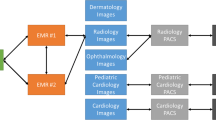Abstract
The intent of this project was to use object storage and its database, which has the ability to add custom extensible metadata to an imaging object being stored within the system, to harness the power of its search capabilities, and to close the technology gap that healthcare faces. This creates a non-disruptive tool that can be used natively by both legacy systems and the healthcare systems of today which leverage more advanced storage technologies. The base infrastructure can be populated alongside current workflows without any interruption to the delivery of services. In certain use cases, this technology can be seen as a true alternative to the VNA (Vendor Neutral Archive) systems implemented by healthcare today. The scalability, security, and ability to process complex objects makes this more than just storage for image data and a commodity to be consumed by PACS (Picture Archiving and Communication System) and workstations. Object storage is a smart technology that can be leveraged to create vendor independence, standards compliance, and a data repository that can be mined for truly relevant content by adding additional context to search capabilities. This functionality can lead to efficiencies in workflow and a wealth of minable data to improve outcomes into the future.



Similar content being viewed by others
References
“Object Storage Alliance.” Neuralytix. Available at http://www.neuralytix.com/osa. Accessed 18 May 2015.
Oosterwijk, Herman. “What Is a VNA, Anyway?” What Is a VNA, Anyway? By Herman Oosterwijk, President, OTech Inc. Available at http://www.himss.org/files/HIMSSorg/content/files. Accessed 18 May 2015.
Yeager, David. “Vendor-Neutral Archive or Archive-Neutral Vendor?” Vendor-Neutral Archive or Archive-Neutral Vendor? Radiology Today, n.d. Web. 2015.
“Difference Between NFS and CIFS | Difference Between | NFS vs CIFS.” Difference Between NFS and CIFS | Difference Between | NFS vs CIFS. N.p., n.d. Web. 2015.
HITRUST. Health Information Trust Alliance. Available at https://hitrustalliance.net. Accessed 28 Dec 2015.
Committee, IHE Radiology Technical. IHE_RAD_Suppl_IID_Rev1.2_TI_2015-04-21 (n.d.): n. pag. Ihe.net. IHE. Web. 2015.
“Claron Receives FDA 510k Clearance For NilRead Diagnostic Zero-Footprint Medical Image Viewer.” Health IT Outcomes. Available at http://www.healthitoutcomes.com/doc/claron-nilread-diagnostic-zero-footprint-medical-image-viewer-0001 Accessed 28 Dec 2015.
“Client Outlook awarded FDA 510(k) Class II Medical Device Clearance for eUnity” Client Outlook Inc. Available at http://www.clientoutlook.com/press_release/client-outlook-awarded-fda-510k-class-ii-medical-device-clearance-for-eunity. Accessed 28 Dec 2015.
“DICOMweb.” DICOMweb. Available at http://dicomweb.hcintegrations.ca/#/home. Accessed 18 May 2015.
“Solr Features.” Apache Solr. Apache. Available at http://lucene.apache.org/solr/features.html . Accessed 18 May 2015.
HL7 International. “CDA Release 2.” Available at http://www.hl7.org/implement/standards. Accessed 18 May 2015.
“Dsr2xml: Convert DICOM SR File and Data Set to XML.” OFFIS DCMTK. Available at http://support.dcmtk.org/docs/dsr2xml.html. Accessed 18 May 2015.
“6.5 WADO-RS Request/Response.” 6.5 WADO-RS Request/Response. Available at http://medical.nema.org/dicom/2013/output/chtml/part18/sect_6.5.html. Accessed 18 May 2015.
Channin, David S. et al. “The caBIGTM Annotation and Image Markup Project.” Journal of Digital Imaging: the official journal of the Society for Computer Applications in Radiology 23.2 (2010): 217–225. PMC. Web. 2015.
“ImageJ.” ImageJ. Available at http://rsb.info.nih.gov/ij/index.html. Accessed 18 May 2015.
“CDA Guideline Validation.” CDA Guideline Validation. Available at http://cda-validation.nist.gov. Accessed 18 May 2015.
“ePAD: A Cross-Platform Semantic Image Annotation Tool” RSNA. Available at http://www.researchgate.net/publication/266104399_ePAD_A_Cross-Platform_Semantic_Image_Annotation_Tool. Accessed 18 May 2015
“Documentation Overview.” CURL. Available at http://curl.haxx.se/docs/. Accessed 18 May 2015.
Systems, Hitachi Data. “HCP Using HS3 API.” (n.d.): n. pag. Hitachi Data Systems. Web. 2015.
“RadLex Term Browser.” RadLex Term Browser. Available at http://www.radlex.org. Accessed 18 May 2015.
“Understanding the Principles of Algorithm Design - Tuts+ Code Tutorial.” Code Tuts+. N.p., n.d. Web. 2015.
“OpenNLP.” Solr Wiki. Available at https://wiki.apache.org/solr/OpenNLP. Accessed 18 May 2015.
Author information
Authors and Affiliations
Corresponding author
Rights and permissions
About this article
Cite this article
Bialecki, B., Park, J. & Tilkin, M. Using Object Storage Technology vs Vendor Neutral Archives for an Image Data Repository Infrastructure. J Digit Imaging 29, 460–465 (2016). https://doi.org/10.1007/s10278-016-9867-z
Published:
Issue Date:
DOI: https://doi.org/10.1007/s10278-016-9867-z




